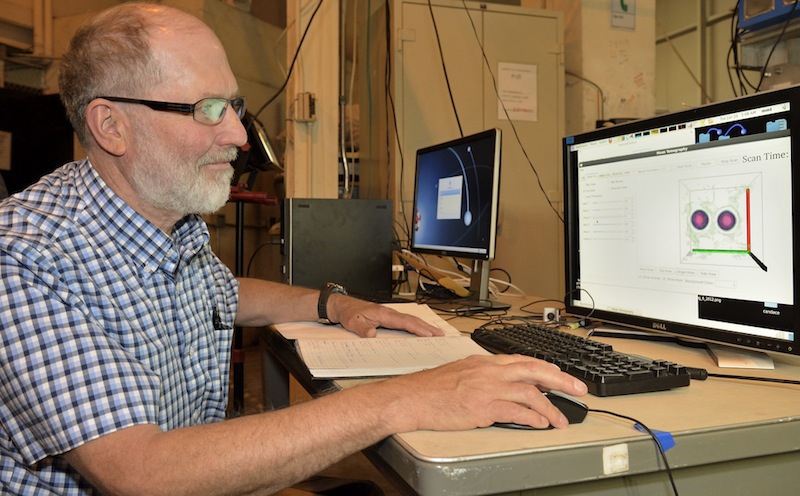
Features
Safety
Safety News
Accelerating Fukushima cleanup with muon tomography
June 18, 2014 | By Anthony Capkun

June 18, 2014 – A Los Alamos technique called muon tomography is said to be able to safely peer inside the cores of the Fukushima Daiichi reactors and create high-resolution images of the damaged nuclear material inside without ever breaching the cores themselves. The initiative—scheduled for development in partnership with Toshiba Corporation—could reduce the time required to clean up the disabled complex while reducing radiation exposure to personnel working at the plant.
PHOTO 1: Christopher Morris, leader of Los Alamos National Laboratory’s Muon Tomography Project, watches an image of two dense hemispheres of lead develop on a computer screen after just over a minute of exposure to muons (naturally occurring particles generated by cosmic rays interacting with Earth’s atmosphere). Morris and colleagues have developed a method to use muons to peer inside closed containers—even very dense ones—to detect smuggled nuclear materials or to peer inside damaged nuclear reactor cores, like those at the Fukushima Daiichi complex in Japan.
“Our recent technical work has clearly shown that the muon-scattering technique pioneered at Los Alamos provides a superior method for obtaining high-resolution images of nuclear materials inside structures, and this will allow plant operators to establish the condition of reactor-core material without the need to actually get inside,” said Duncan McBranch, Los Alamos’s chief technology officer.
Muon radiography (also called cosmic-ray radiography) uses secondary particles generated when cosmic rays collide with upper regions of Earth’s atmosphere to create images of the objects that the particles—called muons—penetrate. The process is analogous to an X-ray image, except muons are produced naturally and do not damage the materials they contact.
“Los Alamos researchers began working on an improved method for muon radiography within weeks of the 2011 earthquake and tsunami that damaged the Fukushima reactor complex,” said Morris. “Within 18 months we had refined our technique and published a paper showing that the Los Alamos method was superior to traditional muon radiography techniques for remotely locating and identifying nuclear materials, and that it could be employed for field use.”
As part of the partnership, Los Alamos will assist Toshiba in developing a muon tracker for use at the Fukushima plant.
“We are hopeful that our partnership with Toshiba will assist the Tokyo Electric Power Company and the Japanese government in their efforts to accelerate cleanup operations in the safest way possible,” added McBranch.
PHOTO 2: Los Alamos National Laboratory post-doctoral researcher Elena Guardincerri (right) and undergraduate research assistant Shelby Fellows prepare a lead hemisphere inside a muon tomography machine.
Print this page